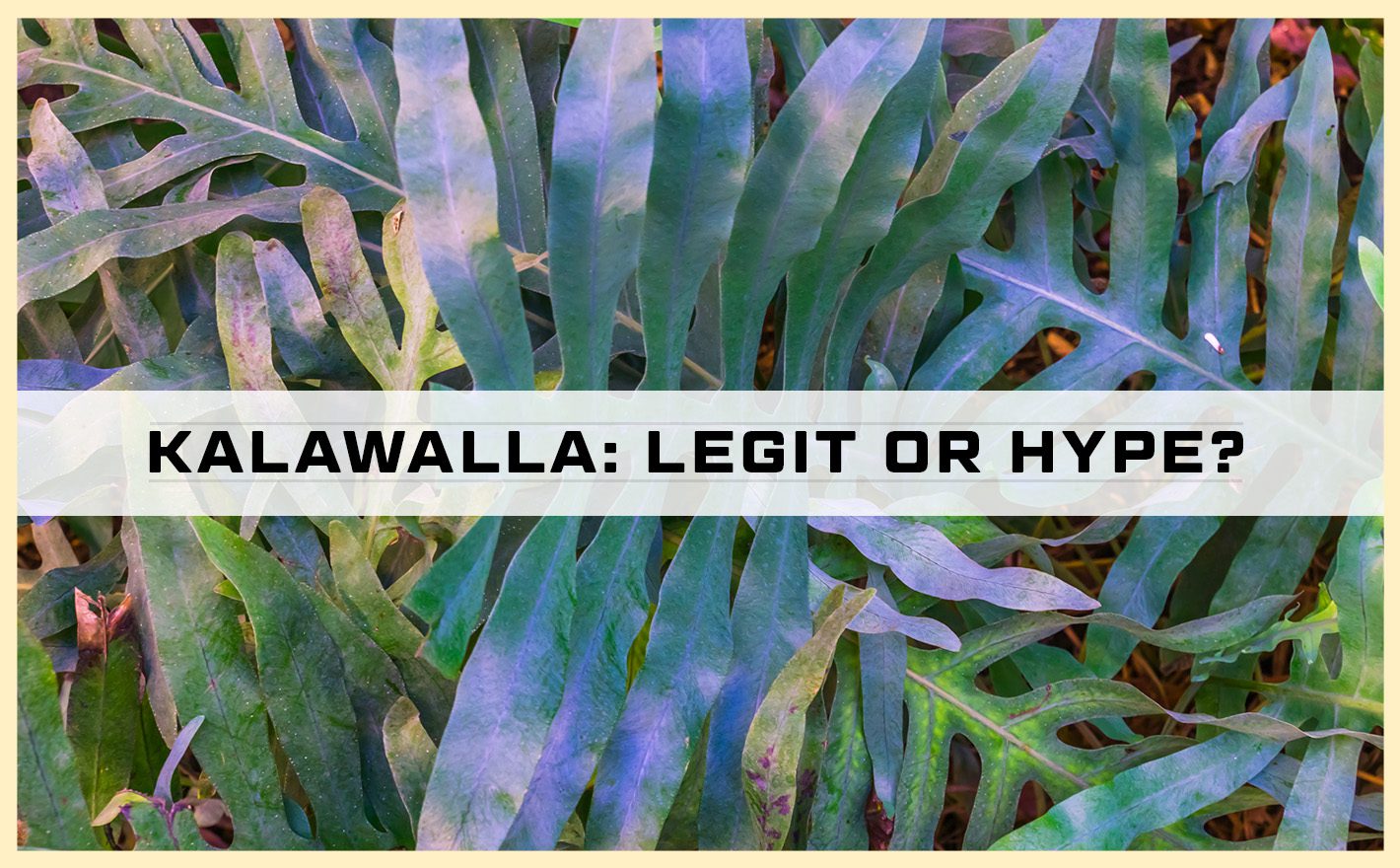Kalawalla root is an herb that seems to be rapidly gaining popularity for skin health, but is there any evidence that it’s effective, or is it just another over-hyped fad supplement?
In a world where people increasingly get their health information from TikTok videos, it’s commonplace for supplements to get crazy popular overnight. That being said, we were pleasantly surprised by our literature review of Kalawalla.
Other names for Kalawalla include ‘Calaguala’, ‘Blue Star Fern’, ‘Golden Serpent Fern’, and its formal designation Polypodium leucotomos. A tropical herb native to Central and South America, it’s been used in Central American folk medicine for centuries and was popularized in part by Dr. Sebi, a now-deceased Honduran herbalist with a dedicated online following.
According to our research, one thing is clear: Kalawalla has significant anti-inflammatory abilities and there’s ample evidence to suggest that it can protect the skin from UV damage. It’s certainly no panacea, but–based on the research–its ability to support skin health seems quite promising.
WebMD, however, dismisses the herb outright:
“People use Polypodium leucotomos for sunburn, eczema, dark skin patches on the face, cancer, and many other conditions, but there is no good scientific evidence to support these uses.”
It’s unfortunate that such a well-known online health resource would give such a pat answer to the question of whether or not Kalawalla is beneficial. At the very least, if they had issues with the available research on it, they could have specifically critiqued the studies.
Kalawalla herb benefits
Based on our review, WebMD is totally wrong about this herb.
A quick search on PubMed furnished us with a number of different studies on Kalawalla, demonstrating the following potential benefits:
- Protection against UV damage
- Reduction of mitochondrial mutation in skin and connective tissue cells
- May benefit those with vitiligo
- Soothes eczema (atopic dermatitis)
- Reduces sun rashes
Now, let’s break down the research in detail.
Kalawalla root protects the skin from UV radiation
Prevailing attitudes toward sunlight are confusing and contradictory.
We live in a society where we’re often admonished to avoid direct sunlight like the plague, and yet we’re also told how beneficial it is for us.
The benefits of sunlight go way beyond vitamin D. Research has shown that it can also lower blood pressure by increasing nitric oxide synthesis, enhance sleep quality, and support mood health by boosting serotonin.
That being said, it’s clear that too much UV exposure can cause damage, primarily by increasing free radicals (also known as ROS, which stands for ‘Reactive Oxygen Species’).
In the alternative health world especially, a number of different antioxidants are often recommended to reduce UV damage, including nutraceuticals like astaxanthin, Vitamin E, CoQ10, and many others.
Kalawalla root contains a variety of antioxidant compounds that can protect your skin, including (but not limited to):
- Caffeic Acid
- Ferulic Acid
- Vanillic Acid
- Chlorogenic Acid
According to a literature review of a commercially available extract of Kalawalla, caffeic and ferulic acid are the two most potent antioxidant compounds it contains. Used both topically and internally, this particular extract has undergone multiple human clinical trials.
In a 2017 study of 40 people, Kalawalla extract increased skin hydration, elasticity, and reduced redness. Another study exposed volunteers to artificial UV radiation and performed skin biopsies afterward, noting that the herb was able to reduce the number of damaged cells as well as the presence of mast cells, a component of the immune system that releases histamine and other inflammatory mediators.
Kalawalla root reduces mitochondrial DNA mutation
In the course of studying this herb, we came across an interesting new term: ‘common deletion’ (often abbreviated in the literature as ‘CD’).
A 2010 paper on Kalawalla explains the term thusly:
“The common deletion (CD) is a 4977 base pair–long mitochondrial DNA whose deletion is induced by, and is a marker of, chronic UVA radiation in fibroblasts and keratinocytes.”
To translate into somewhat plain English: Ultraviolet light from the sun can alter a specific bit of DNA in your skin’s mitochondria (the part of the cell that produces energy). The deletion of this DNA is a marker for excessive UV exposure in both the cells that form connective tissues (fibroblasts), and the main type of cell that forms the skin (keratinocytes).
Are you a massive health geek like us, and want to learn more about the relationship between mitochondrial gene mutation and health? If so, here’s a great video on that topic by world-renowned expert on mitochondria genetics, Dr. Douglas C. Wallace.
Also, if you’re looking to naturally support your cells’ energy factories, check out this article on CHOQ Shilajit, which is standardized for both fulvic acid and urolithin A (a naturally occurring compound in Himalayan Shilajit that supports healthy mitochondrial function).
If you’d like to learn more about Kalawalla’s antiaging, photoprotective, and DNA-preserving properties, this presentation by a dermatologist is a great resource that draws from multiple human clinical studies.
Kalawalla root may help people with vitiligo regain skin pigmentation
Thought to be an autoimmune disorder, vitiligo is a condition in which pigment-making cells (called ‘melanocytes’) are destroyed, resulting in patches of skin that lack any color.
The Internet is replete with stories of Kalawalla’s autoimmune-regulating properties, and though research in this area is minimal, these studies on vitiligo are promising examples.
A 2007 study used Kalawalla capsules in conjunction with UVB therapy for about 6 months, and found that the herbal extract increased repigmentation in the head and neck, though other parts of the body were not affected.
A more recent study done in 2021 also combined oral Kalawalla root with ultraviolet light therapy for about 6 months and had similar success.
Kalawalla root may benefit people with eczema
A 2012 study compared Kalawalla to placebo in children who suffered from eczema (AKA ‘atopic dermatitis’).
Though the effect of Kalawalla capsules on eczema was not particularly pronounced, it was still significant enough to warrant further investigation. The researchers found that the kids who took the herbal extract were able to reduce their use of antihistamines.
Kalawalla reduces sun rashes
Kalawalla was shown in a 2011 study to benefit those suffering from sun rashes…though that’s a slight oversimplification for the sake of clarity.
In particular, the study looked at ‘idiopathic photodermatoses’, which it defines as “recurrent, acquired sunlight-induced rash of delayed onset, appearing after exposure to ultraviolet radiation in susceptible individuals.”
The researchers found that nearly 75% of the participants benefited from taking Kalawalla extract, noting a “significant reduction of skin reactions and subjective symptoms.”
Final Conclusion: is Kalawalla legit or not?
Without oversimplifying the situation, we’ll say this: Kalawalla root shows a heck of a lot of promise when it comes to supporting skin health–especially UV protection–and we’re super excited to see more studies on it in the future.
Zooming out a bit, one thing that studying herb has brought into clear focus is the need to protect ourselves against mutagens, as UV radiation isn’t by any means the only thing in our environment that can shred our DNA.
Antioxidants are absolutely essential to health, both in food and supplement form.
If you’re looking for the ultimate antioxidant protection against a wide variety of toxic mutagens (like pesticides and heavy metals) then check out APEX Glutathione, the most advanced glutathione supplement on the market.
APEX is an ultra-comprehensive formula that consists of liposomal glutathione, NAC, and 11 other ingredients, all expertly formulated to optimize detoxification, immune health, and cognitive function. If you’re looking for an all-in-one, super potent antioxidant formula that also boosts mood & focus, then APEX Glutathione might just be your new best friend.
Lastly, if you’d like to learn more about the critical role that antioxidants play in health or how to protect yourself from free radicals and other common toxins, you’ll love these articles:
- 350,000 Reasons to Take Glutathione (and how it actually works in your body)
- Hormones Under Fire: Worse Living Through Chemistry
- You’re Being Straight Up Lied to About Natural Flavors
- PFAS: the Forever Chemicals
- How Plastics Can Alter Your Genitals
- Man Drinks Glyphosate on Camera
- Propaganda Alert: BPA is Safe
- Glyphosate Exposed: the Séralini Papers


